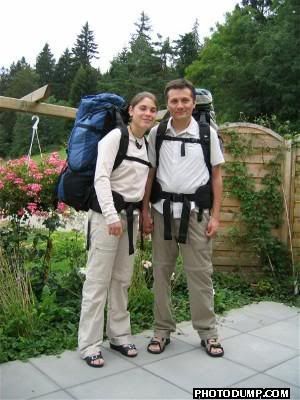Saturday, August 06, 2005
Malaysia: Sabah
Sabah is the second largest state in Malaysia, after Sarawak. It is situatated on the northern tip of Borneo and has roughly the same size as Belgium and Holland put together.
Sabah's ethnic mix is very different from the rest of Malaysia. There are over 30 indigenous groups, and the Malays and Chinese are only small minorities. The Kadazan/Dusun, traditionally farmers, constitute the largest group, along with the Murut, who live in longhouse communities in the hills of the Southwest, and the Bajau.
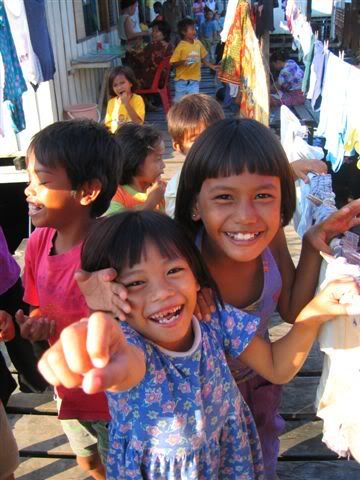
The Bajau originally migrated from the Sulu archipelago centuries ago. On the West Coast of Sabah, they became farmers and are famous for breeding small horses. On the East Coast, they are also known as "sea gypsies" and make a living harvesting the seas.
Other minorities include the Orang Sungei ("river people"), Brunei (like in the oil-rich sultanate), Rungus (well known for their touristy longhouses)... Recently, there has been a huge influx of Filipino and Indonesian immigrants, especially on the East Coast.
Some history...
The sultanates of Brunei and Sulu have traditionally claimed this territory, although the locals might not have been aware of their overlords.
In 1865, Sabah got in the hands of the American Trading Company, who sold its rights to the British North Borneo Chartered Company (BNBCC) in 1888. The BNBCC rule was generally peaceful except for small pockets of resistance, the most serious being the Mat Salleh War from 1894-1900 and the Rundum resistance by the Muruts in 1915.
The BNBCC effectively ruled up to 1942, when the Japanese forces swept through Borneo. After the Second World War, as the bankrupt BNBCC could not afford the cost of rebuilding it, Sabah became a british colony.
In 1963, Sabah joined the Malaysian Federation. As a state within a federation, many changes occurred administratively, politically and socially. Not always to the satisfaction of the population.
The peak of confusion was attained in 1985, when the Christian Joseph Pairin's opposition party won the state elections. It was the first time a non-Muslim attained power in a Malaysian state. The reaction of the federal government was to cut fundings to the state, and to carry out a blatant pro-Muslim propaganda which ran as far as offering Christians cash incentives to convert to Islam. On the other hand, Pairin encouraged immigration of Christians from Timor to tip the balance the other way. Anti-federal feelings were worsened by the fact 95% of the profits from Sabah's flourishing crude oil exports were siphoned off to Kuala Lumpur.
Since 1999, the relations with Malaysia took a change for the better when elections were won by parties aligned with the Barisan Nasional, the government's dominant coalition. This brought some visible progress. But Sabah, still mined by cronyism and nepotism, is economically far behind Sarawak who has a more stable governement and more institutionalised approach to development.
Labuan
The small arrowhead shaped island of Labuan was our first stop after we left Brunei by ferry.
For such a tiny island, it has a relatively interesting history. The island was "given" by Brunei to Queen Vistoria in 1846, after the British expressed their keen interest in establishing a coal station for steamship and a trade post. The project flopped as swamps made the place was very unhealthy, and coal deposits were not as big as expected! Later, in 1942, Japan launched its invasion of Borneo from Labuan, and surrendered it there 45 months later. Their legacy of sunken ships now make Labuan famous with wreck divers.
But Labuan is better known to Malaysians, Bruneians and expats as a duty free port where alcohol is cheap. Many street cafes, bars with live bands and karaoke joints provide entertainement. The compact town centre and the laid-back atmosphere makes it all very agreable and manageable, and the absence of spectacular sights on land left us with nothing more to do than relax. Together with cousins from Brunei.
The view from our hotel room (the two rockets in the background are not weapons of mass destruction):
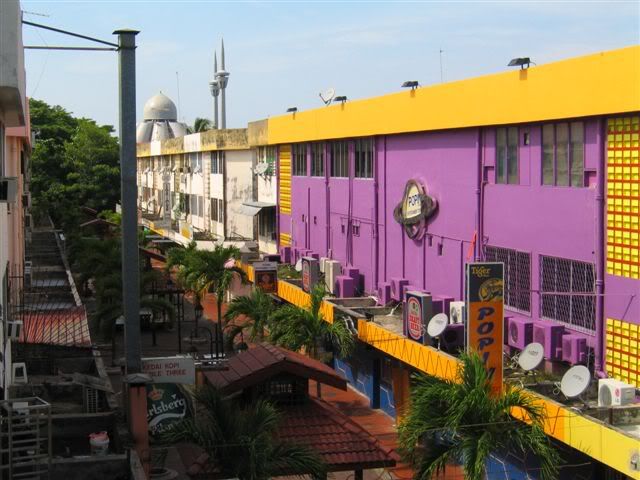
Kota Kinabalu and around
We first hit Kota Kinabalu (KK for the Malaysians), the capital of Sabah, at the peak of high season and all backpacker hotels were fully booked. Thanks to relatives who came to meet us at the port on our arrival, we found centrally located accomodation. The second time we arrived (at the end of our Sabah tour), we encountered a similar situation. It was the week-end of the university graduation ceremonies, with proud parents flooding the city!
As a consequence of its total destruction during WWII, there are not many old buildings in town. But it is still has an indefinite charm to it, maybe due to the friendliness of the people and the laid-back, rather permissive atmosphere.
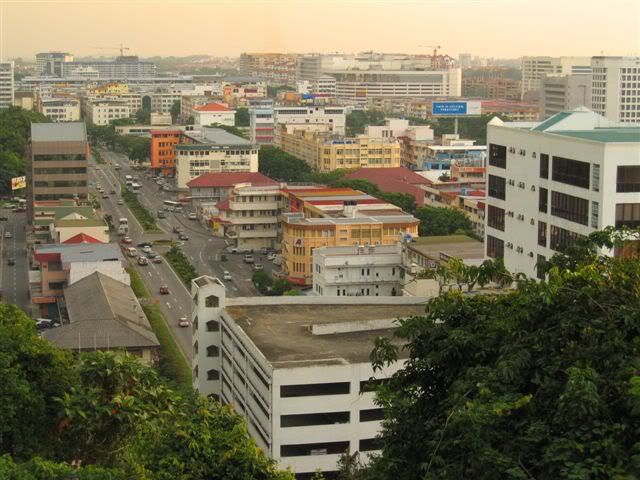
The Sabah museum is probably the only must-see tourist attraction in town. We liked the exhibit on the local ethnies based around their traditional costumes, jewelry and daily life objects, the collection of stuffed animals with a Borneo rhinoceros as highlight, and the display of imposing jars used by Asian merchants for barter-trading with the natives in the old days. The rest was much less exciting: the well-made but rather sterile traditional houses in the museum's gardens, a pathetic gallery of works from local Gauguin, Cezane or Andy Warhol wannabes, a hagiography of the current Chief Minister of Sabah, the oil exposition...
The adventures with our Uncle Max and his vintage Land-Rover were much more memorable: the beautiful views from KK and the bay, the stunning evening light at a deserted birds sanctuary (see below), the refreshing breeze at the new seafront, the lunch and house ricewine at a Dusun home-restaurant-karaoke outside town, the energetic resident cover bands at the Rawk! and the Shenanigans pubs...
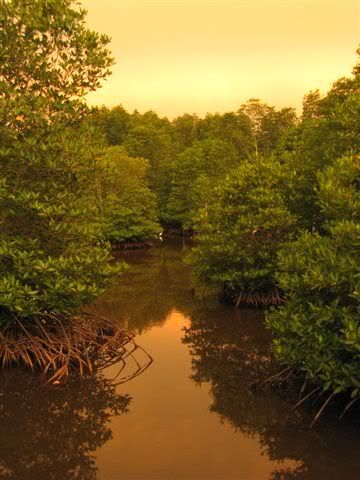
We also enjoyed a Sunday hang-out with more relatives and an equally nice but more sober time attending a Brunei wedding in Papar, invited by our friend Harry whom we met in Semporna.

To get an idea of the Bajau farmland, we took the minibus to Kota Belud , a model village during the time of the British. In their time, they tried to screen the locals from the outside world to preserve their traditions, while teaching them the benefits of modern agriculture methods and hygiene. Nowadays, Kota Belud is feared for witchcraft, but we wouldn't have noticed if no-one had told us! And as expected, progress left its mark. But we still saw some nice wet-rice fields from the road.
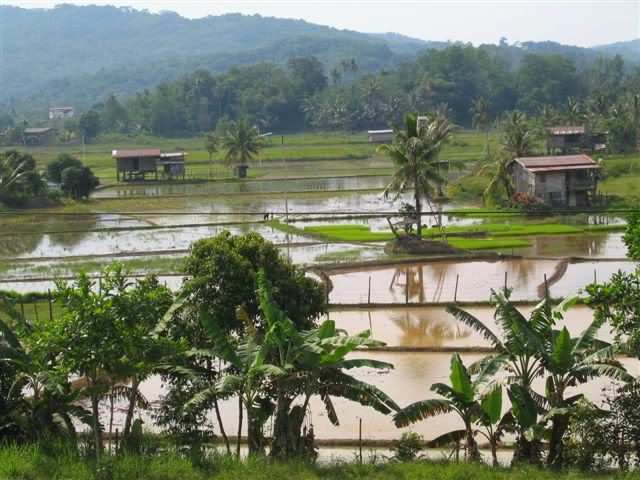
Mount Kinabalu Parks
The Mount Kinabalu Parks are an area of superlatives, that surely fill a whole chapter in the "Malaysian Book of Records". Highest summit in South-East Asia, one of the largest biodiversity in the world, biggest pitcher plants, most orchids, most visitors for a national park in Malaysia, highest public telephone in the world (out of order), etc.
Towering at 4096m, Mt.Kinabalu stands unchallenged by any of its neighbour in the Crocker range. This situation has led to the development of strates of different forest types, isolated by altitude, and rich with endemic fauna and flora.
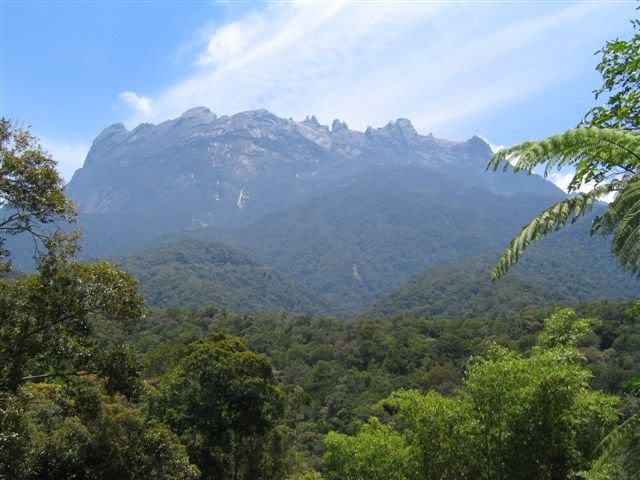
At 1500m and above, the air is usually fresh, and sometimes cold. We had a fantastic time hiking along the many trails around the mountain, looking for orchids and pitcher plants, stumbling on strange ferns and rhododendrons, spotting a few endemic birds, bugs and reptiles. It was the blooming season for the orchids, and we were happy to see the flowers of some 25 varieties, out of the 750 or so recensed in the Parks.
Sadly, this extraordinary biodiversity goes unnoticed by the vast majority of the climbers, who "rush" up and down the mountain in two days. As we went up the classical way from the headquarters, and down the more beautiful, but longer new alternative way to Mesilau, we only had to deal with the herd on half of the way.
So, as we walked up, we passed snailing columns of determined Taiwanese, Korean and Japanese middle-aged "mountaineers", resting groups of merry students from KL and Singapore trying to beat their previous record, and struggling tanned backpackers rudely remained of their unhealthy regimes on the beach. All coming for the glory of climbing the slope (which, for 10 ringgits, can be duly acknowledged by a certificate), a 50% chance of a stunning view at the top and a pair of painful legs for the next 4 days. Between this quasi static mass, little porters run up and down, sometimes 3 times a day, with loads of 60 kilos on the back.
The climb is normally done in 2 stages. The first day is spent ascending to 3300m, to the huts at Laban Rata. On the way, the vegetation gradually changes, recedes to forests of bonsai as the panoramic view on the land below is revealed, and eventually dissapears at around 3500m.
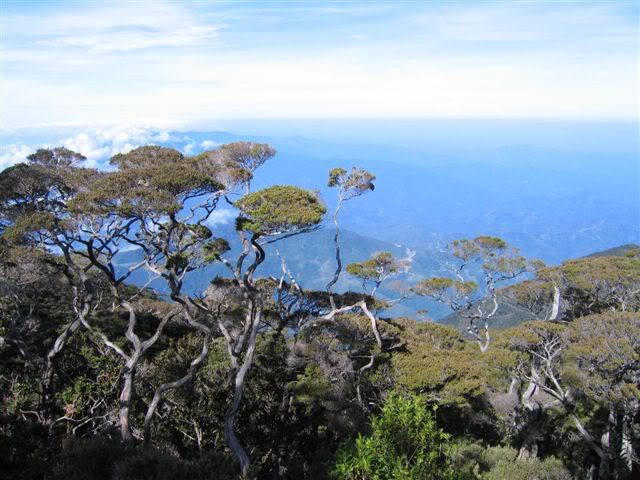
Going for the summit at 3:30 am, after a sleepless night in an overheated and stuffy room, the sight was exceptionally clear and the lights of KK were visible in the distance. At 5 o'clock, we were on the highest peak, shivering and awaiting a glorious sunrise half an hour later. Alas, this was slightly spoilt by the sudden arrival of sheets of mist. But then it cleared up again, and we could see all the other peaks and the valleys below.
Posing for posterity:
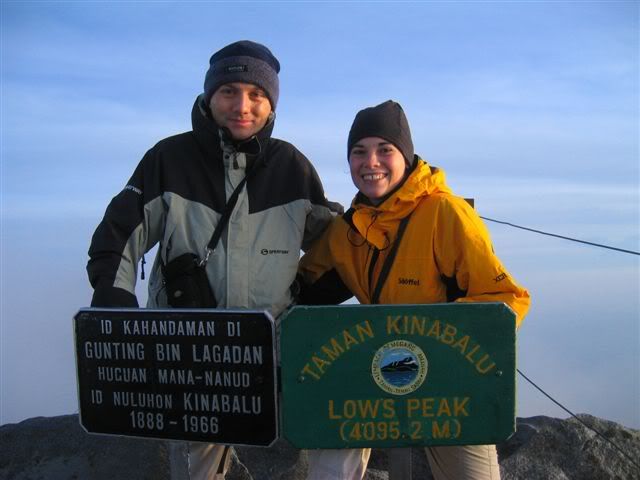
The trail down was beautiful and quiet. It had a much wider array of plants than the classical path, and on that day, only us and a group of 6 people going up used it. When we reached Mesilau, it was like a ghost resort. There was no other guests in sight.
The next day, we walked the Nepenthes trail guided by Sukaibin, a Dusun enthusiastical botanist working in the park. A wonderful walk! We saw slipper orchids, the huge Nepenthes Raja (see below), and many other plants and birds... We had already encountered some on our previous explorations without knowing their name. After this 4 hours crash course, we really had the impression of knowing much more than before!
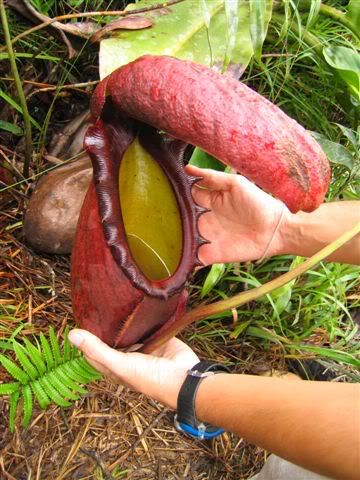
Our last couple of days in the region we spent at the Poring hot springs, meeting again with the crowd resting their sore legs in the sulphur bath.
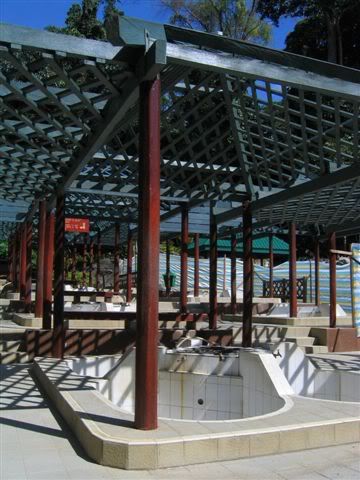
At an altitude of 600m, the weather was notably hotter and the low mountain forest was dominated by tall diptocarps. Beside bathing, we followed the nice, deserted trail to a very high waterfall. It passed some impressive patches of big bamboos and had a couple of lowland orchids to add to our picture gallery.
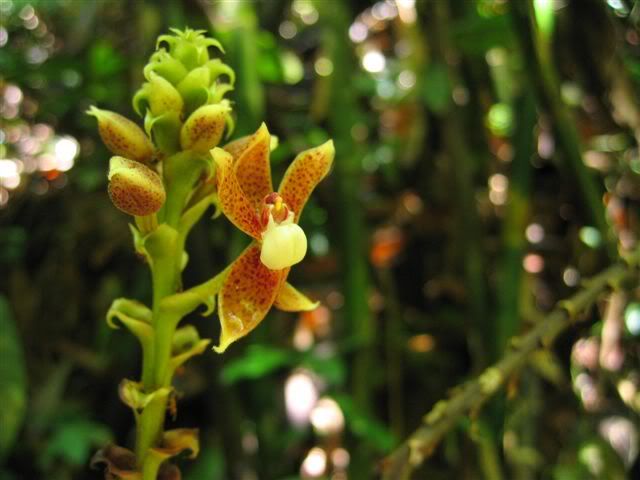
We did the canopy walk (the highest in the world?) in the early morning, but saw no birdlife. Instead, on our return, we crossed a beautiful green lizard who froze for a photo-session.
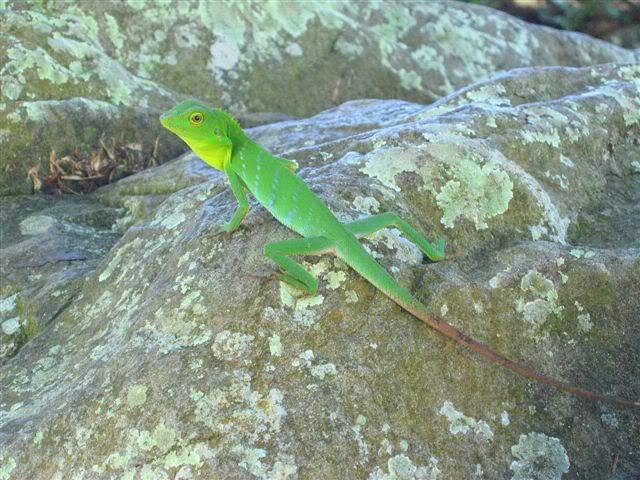
Sandakan
Sandakan was the capital of Sabah under the Chartered Company's rule. It was made famous by Agnes Newton Keith's pre-war recollections in "Land Below the wind". She came to Sandakan in 1934, following her husband, Harry Keith, who was head of the North Borneo forestry department. He established the first conservation projects on Borneo, protecting amongst others the area around Mt.Kinabalu. He left such a lasting impression that a variety of rafflesia flower is named in his honour. We visited their "house on the hill", now renovated into a museum, from which we could admire that "view of the bay" Agnes loved so much.
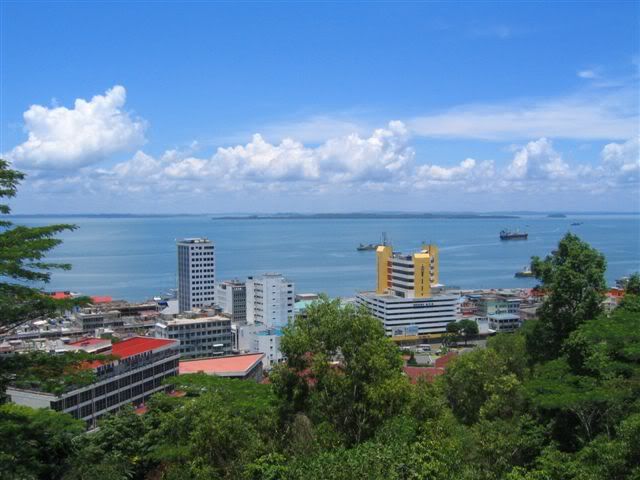
Portraits of the Keith family:
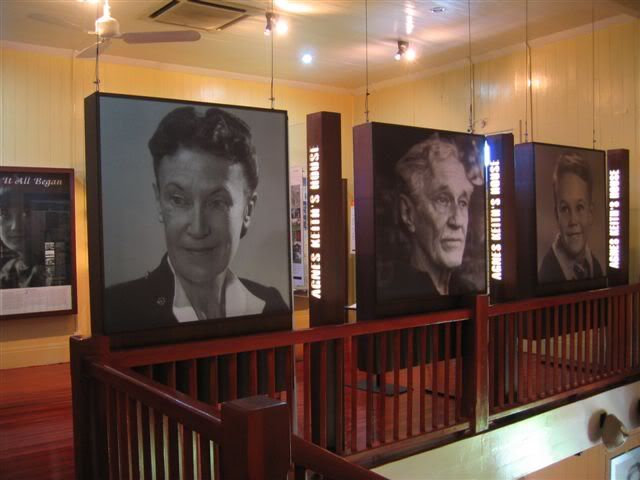
Sandakan has a wilder feel than KK. A typical cowboy town, with a very large friendly Filipino community. Fortunes were made during the logging boom of the 1970-1980s, and most of them lost by now, after the industry collapsed when all the big trees had been cut.
The Sunday market:
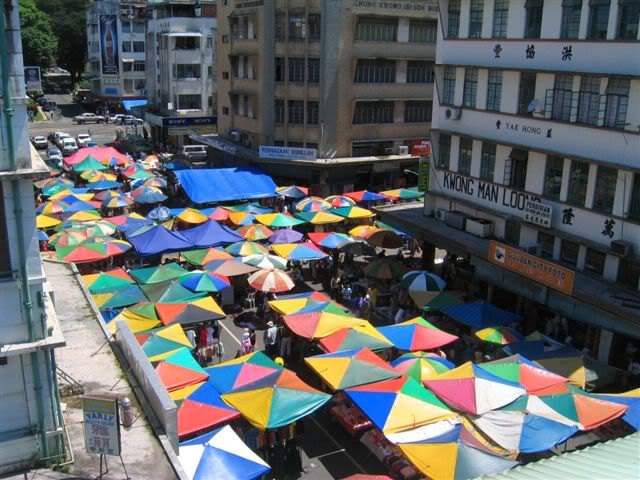
We were also lucky to meet yet another nice Uncle (Donald!) who kindly offered to drive us around to view points, the water village and some good eating places. And also helped us organise our Kinabatangan trip.
Wildlife On The Lower Kinabatangan
The lower reaches of the Kinabatangan, the longest river of Sabah, are abundant in wildlife. This is the territory of the Orang Sungei, mostly Muslim and thus having mild hunting habits. Except for deer, wild cattle and fish, they left the other animals relatively undisturbed. These are much more threatened by the destruction of their habitat for timber, plantations, the construction of roads and human settlements.
The forest along the shores has been regularly logged. The canopy is low, the undergrowth is not too thick and it doesn't form the same green wall we saw in pristine areas of Sarawak. This makes wildlife spotting easier.
For absence of a better choice, we booked a stay at "Uncle Tan's" (which, for a change, is not our uncle). At first, we were reluctant as their name was on the lips of every traveller we met. They have a camp in the nature, with good, but basic facilities, motivated young staff and a solid set of activities to keep their customers busy and happy. As a result, they are well established on the backpacker's itinerary, and, we think, fully deserve their excellent reputation.
The program consisted of morning, evening and night speedboat cruises on the river to see, with near certainty, proboscis monkeys, leaf-monkeys, long and pig-tailed macaques, crocodiles, monitor lizards, hornbills (black and oriental pied), eagles (white belly and crested) and owls.
Cruising in the early morning mist:
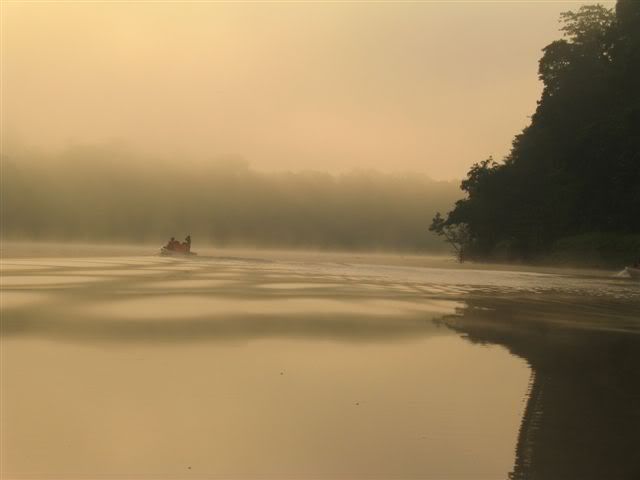
They also organised short treks on the trails around the camp. During the day, mostly to show the plants, and during the night (our favourite!), to search for little frogs, sleepy birds, strange insects and less recommendable creatures like tarantulas and centipedes. It is during one of these night walks that we saw a rare banded civet cat, who looked back at us for a while.
A poisonous centipede, which inflicts the most painful sting of the forest:
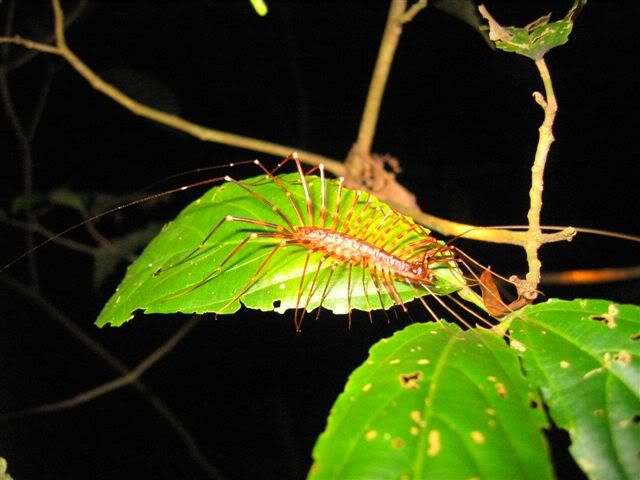
We stayed an extra day and took time to explore the tracks by ourselves in search of the elusive pygmy bornean elephants (who are just slightly smaller than their asian cousins) and orang-utans who sometimes build their nests there. After hearing a strange noise in the jungle, which could have been a sunbear or a wild cat, we left the path and stumbled through the vegetation to eventually catch a short glimpse of the arms and tails of shy evading silver leaf-monkeys. On the way back, the amazing sight of the shallow orange and red oxbow lakes, who were former meanders of the river, made up for our relative lack of luck.
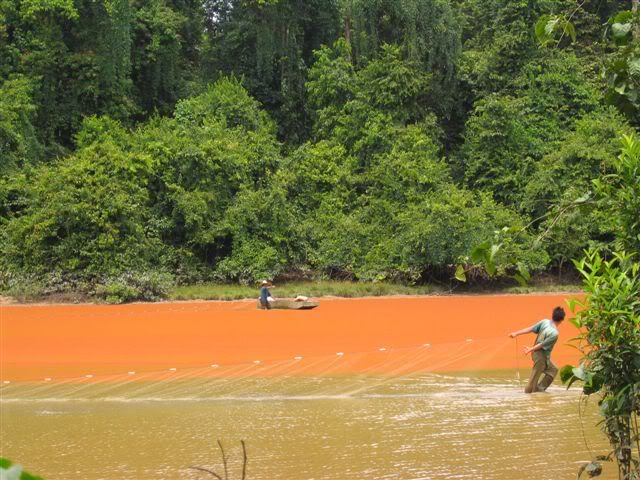
And last but not least, we met some really nice fellow travellers, and even the inevitable moronic beach hoppers on their mandatory "jungle" trip couldn't spoil our mood.
A Perfect Waterworld
In Malay, semporna means perfect. Stepping out of the run-down public minibus at night, the badly-lit dirty grid of two-storey shoeboxes which forms the centre of Semporna gave us quite a different first impression!
Having decided to spend a fancy diving holiday, we bypassed the grim hotels in town to splash out on a spacious bungalow in a relatively luxurious resort built on stilts at the waterfront. Hot shower, air-con, the 3 Malaysian channels on the TV and a symbolic breakfast for 14 Euro per night, taxes included.
The view from the floating restaurant where we took our 2 toasts in the morning did justice to the name of the city. The calm waters extending before us became the theatre of fleets of small colourful Bajau boats sailing between the market and the many neighbouring quaint stilt villages.
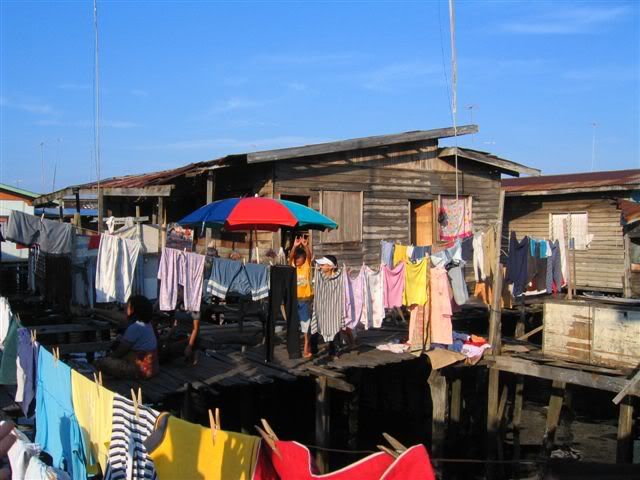
Doing some painting in the port:
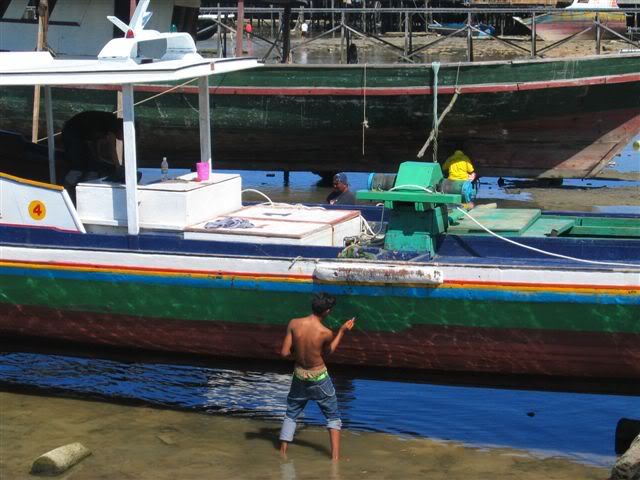
Our main activity for the next 12 days was to explore underwater worlds. The legendary dive sites of Sipadan and Mabul were within a 1 hour boat ride from Semporna. We went with Scuba Junkie, an enthusiastical dive team which organised day-trips of 3 dives to the islands off Semporna.
Sipadan is a divers Mecca, a big coral mushroom, with walls falling vertically down to 600 metres and more, and a breeding ground for turtles. Big hawksbill and green turtle are a sure sight, as well as the elegant and inoffensive white tip reef sharks.
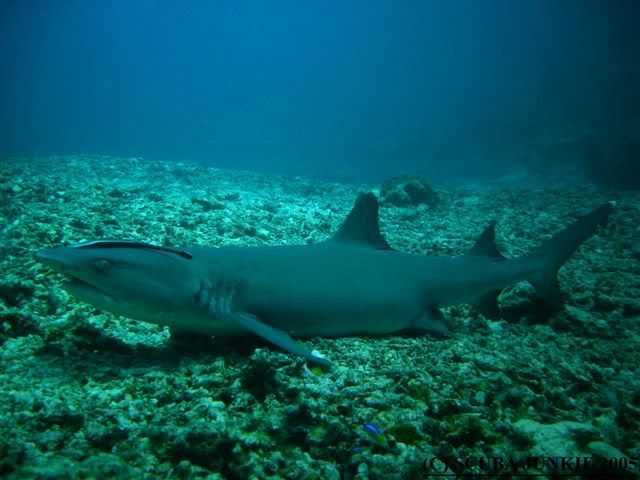
Grey reef sharks, leopard shark and hammerhead sharks can occasionally be seen. But we missed the latter, who hunt in groups in the very early morning and then usually retreat to great depth. Another attraction of Sipadan are the stunning schools of fish: circling barracudas, red-tooth triggerfish, unicorn fish, spadefish, trevallys, bumphead parrotfish, etc. Big solitary Napoleon wrasses and groupers are also fairly common in those waters. But not as common as those:
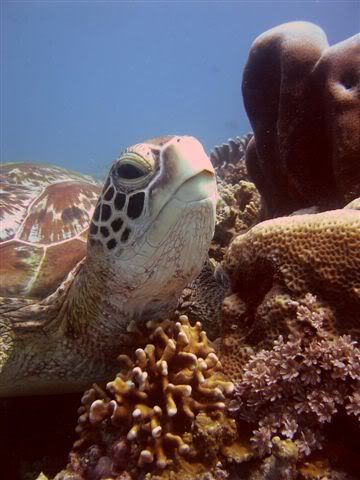
Sunbathing on the empty beach of Sipadan, whose resort has been closed earlier this year for ecological reasons:
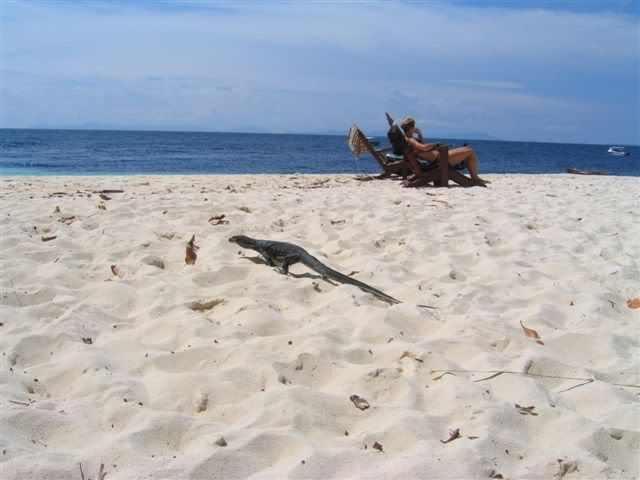
Not far from there, Mabul and Kapalai are known for muck diving. There, not so much big fish swimming around, but the macro life is very rich. The waters are often murky and strange camouflaged creatures lurk on the sandy bottoms and in the hard corals. Crocodile fish (see below), scorpion fish, giant frog fish, pipe fish, flying gunnards, lion fish, moray eels are the stuff to look for!
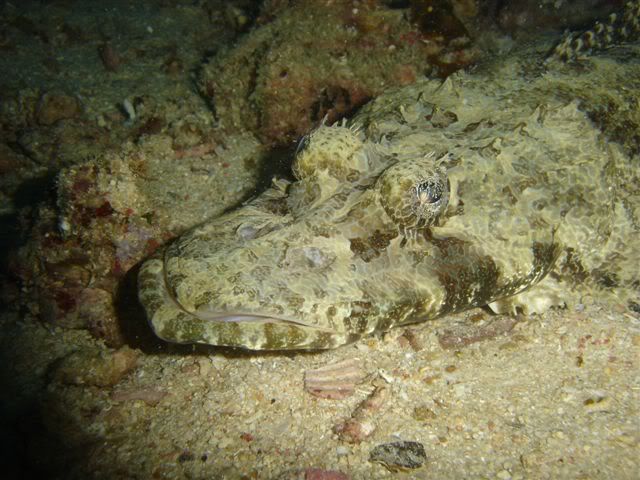
The Bajau village on Mabul:
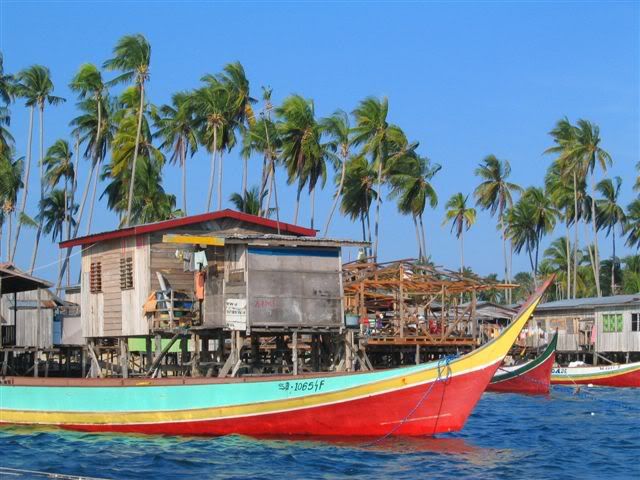
The other islands all have their own particularities, and offer a much less crowded alternative to the previous magnets. Other operators hardly go there, and we were often the only ones to explore those postcard islands.

Mataking had many eels, and we came across some interesting varieties of anemone fish, shrimps and rock lobsters. The highlight of Mantabuan was the impressive black coral forest, with the branches covered by white organisms giving it the apperance of a garden in winter. Bohayan was supposed to be a good spot for big rays, but we "only" saw the most beautiful soft corals garden in the region. Sabangkat was literally infested by extravagant nudibranches. And we saw the shy mandarin fish and other rarities in Sibuan. A fishing house on Sibuan:
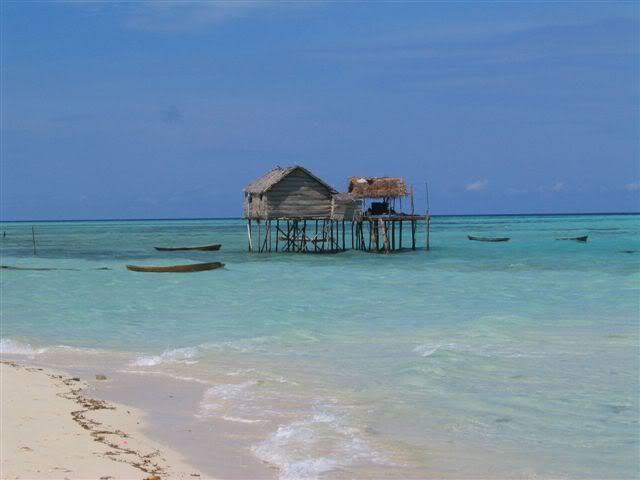
Can you find the frog fish?
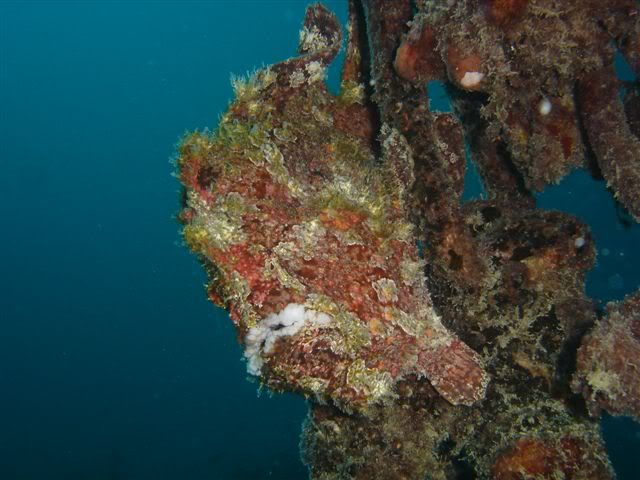
Unfortunately, the bulk of the police patrols concentrate on Sipadan, Kapalai and Mabul, where the expensive resorts and most tourists are, leaving the other islands almost unprotected. Hand-grenade fishing is a big problem, and has already destroyed much of the reef. As a result, the big schools of fish disappeared from those waters.
Few people are aware of the treasures in the hills behind Semporna. On one of our days off diving, we were directed to Bukit Tengkorak , just a few kilometers away from town. There, the luminous green of the high grass replaces the tones of blue of the sea. Black volcanic rocks are dispersed all over the slopes of the hill and eagles soar in the sky on a background of islands and convoluted shores.
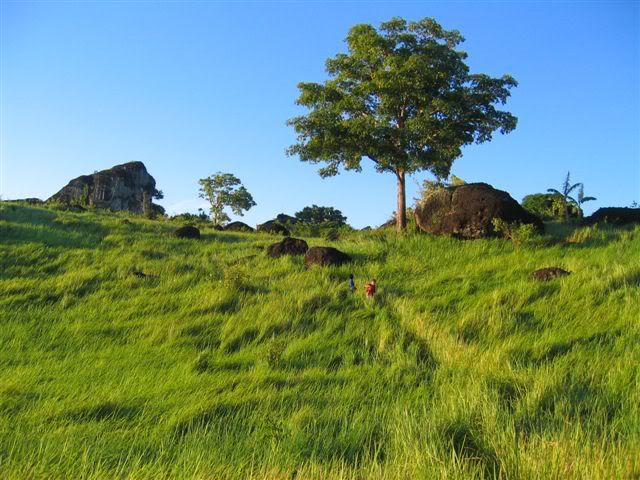
underwater pictures courtesy of Scuba Junkie
Sabah's ethnic mix is very different from the rest of Malaysia. There are over 30 indigenous groups, and the Malays and Chinese are only small minorities. The Kadazan/Dusun, traditionally farmers, constitute the largest group, along with the Murut, who live in longhouse communities in the hills of the Southwest, and the Bajau.

The Bajau originally migrated from the Sulu archipelago centuries ago. On the West Coast of Sabah, they became farmers and are famous for breeding small horses. On the East Coast, they are also known as "sea gypsies" and make a living harvesting the seas.
Other minorities include the Orang Sungei ("river people"), Brunei (like in the oil-rich sultanate), Rungus (well known for their touristy longhouses)... Recently, there has been a huge influx of Filipino and Indonesian immigrants, especially on the East Coast.
Some history...
The sultanates of Brunei and Sulu have traditionally claimed this territory, although the locals might not have been aware of their overlords.
In 1865, Sabah got in the hands of the American Trading Company, who sold its rights to the British North Borneo Chartered Company (BNBCC) in 1888. The BNBCC rule was generally peaceful except for small pockets of resistance, the most serious being the Mat Salleh War from 1894-1900 and the Rundum resistance by the Muruts in 1915.
The BNBCC effectively ruled up to 1942, when the Japanese forces swept through Borneo. After the Second World War, as the bankrupt BNBCC could not afford the cost of rebuilding it, Sabah became a british colony.
In 1963, Sabah joined the Malaysian Federation. As a state within a federation, many changes occurred administratively, politically and socially. Not always to the satisfaction of the population.
The peak of confusion was attained in 1985, when the Christian Joseph Pairin's opposition party won the state elections. It was the first time a non-Muslim attained power in a Malaysian state. The reaction of the federal government was to cut fundings to the state, and to carry out a blatant pro-Muslim propaganda which ran as far as offering Christians cash incentives to convert to Islam. On the other hand, Pairin encouraged immigration of Christians from Timor to tip the balance the other way. Anti-federal feelings were worsened by the fact 95% of the profits from Sabah's flourishing crude oil exports were siphoned off to Kuala Lumpur.
Since 1999, the relations with Malaysia took a change for the better when elections were won by parties aligned with the Barisan Nasional, the government's dominant coalition. This brought some visible progress. But Sabah, still mined by cronyism and nepotism, is economically far behind Sarawak who has a more stable governement and more institutionalised approach to development.
Labuan
The small arrowhead shaped island of Labuan was our first stop after we left Brunei by ferry.
For such a tiny island, it has a relatively interesting history. The island was "given" by Brunei to Queen Vistoria in 1846, after the British expressed their keen interest in establishing a coal station for steamship and a trade post. The project flopped as swamps made the place was very unhealthy, and coal deposits were not as big as expected! Later, in 1942, Japan launched its invasion of Borneo from Labuan, and surrendered it there 45 months later. Their legacy of sunken ships now make Labuan famous with wreck divers.
But Labuan is better known to Malaysians, Bruneians and expats as a duty free port where alcohol is cheap. Many street cafes, bars with live bands and karaoke joints provide entertainement. The compact town centre and the laid-back atmosphere makes it all very agreable and manageable, and the absence of spectacular sights on land left us with nothing more to do than relax. Together with cousins from Brunei.
The view from our hotel room (the two rockets in the background are not weapons of mass destruction):

Kota Kinabalu and around
We first hit Kota Kinabalu (KK for the Malaysians), the capital of Sabah, at the peak of high season and all backpacker hotels were fully booked. Thanks to relatives who came to meet us at the port on our arrival, we found centrally located accomodation. The second time we arrived (at the end of our Sabah tour), we encountered a similar situation. It was the week-end of the university graduation ceremonies, with proud parents flooding the city!
As a consequence of its total destruction during WWII, there are not many old buildings in town. But it is still has an indefinite charm to it, maybe due to the friendliness of the people and the laid-back, rather permissive atmosphere.

The Sabah museum is probably the only must-see tourist attraction in town. We liked the exhibit on the local ethnies based around their traditional costumes, jewelry and daily life objects, the collection of stuffed animals with a Borneo rhinoceros as highlight, and the display of imposing jars used by Asian merchants for barter-trading with the natives in the old days. The rest was much less exciting: the well-made but rather sterile traditional houses in the museum's gardens, a pathetic gallery of works from local Gauguin, Cezane or Andy Warhol wannabes, a hagiography of the current Chief Minister of Sabah, the oil exposition...
The adventures with our Uncle Max and his vintage Land-Rover were much more memorable: the beautiful views from KK and the bay, the stunning evening light at a deserted birds sanctuary (see below), the refreshing breeze at the new seafront, the lunch and house ricewine at a Dusun home-restaurant-karaoke outside town, the energetic resident cover bands at the Rawk! and the Shenanigans pubs...

We also enjoyed a Sunday hang-out with more relatives and an equally nice but more sober time attending a Brunei wedding in Papar, invited by our friend Harry whom we met in Semporna.

To get an idea of the Bajau farmland, we took the minibus to Kota Belud , a model village during the time of the British. In their time, they tried to screen the locals from the outside world to preserve their traditions, while teaching them the benefits of modern agriculture methods and hygiene. Nowadays, Kota Belud is feared for witchcraft, but we wouldn't have noticed if no-one had told us! And as expected, progress left its mark. But we still saw some nice wet-rice fields from the road.

Mount Kinabalu Parks
The Mount Kinabalu Parks are an area of superlatives, that surely fill a whole chapter in the "Malaysian Book of Records". Highest summit in South-East Asia, one of the largest biodiversity in the world, biggest pitcher plants, most orchids, most visitors for a national park in Malaysia, highest public telephone in the world (out of order), etc.
Towering at 4096m, Mt.Kinabalu stands unchallenged by any of its neighbour in the Crocker range. This situation has led to the development of strates of different forest types, isolated by altitude, and rich with endemic fauna and flora.

At 1500m and above, the air is usually fresh, and sometimes cold. We had a fantastic time hiking along the many trails around the mountain, looking for orchids and pitcher plants, stumbling on strange ferns and rhododendrons, spotting a few endemic birds, bugs and reptiles. It was the blooming season for the orchids, and we were happy to see the flowers of some 25 varieties, out of the 750 or so recensed in the Parks.
Sadly, this extraordinary biodiversity goes unnoticed by the vast majority of the climbers, who "rush" up and down the mountain in two days. As we went up the classical way from the headquarters, and down the more beautiful, but longer new alternative way to Mesilau, we only had to deal with the herd on half of the way.
So, as we walked up, we passed snailing columns of determined Taiwanese, Korean and Japanese middle-aged "mountaineers", resting groups of merry students from KL and Singapore trying to beat their previous record, and struggling tanned backpackers rudely remained of their unhealthy regimes on the beach. All coming for the glory of climbing the slope (which, for 10 ringgits, can be duly acknowledged by a certificate), a 50% chance of a stunning view at the top and a pair of painful legs for the next 4 days. Between this quasi static mass, little porters run up and down, sometimes 3 times a day, with loads of 60 kilos on the back.
The climb is normally done in 2 stages. The first day is spent ascending to 3300m, to the huts at Laban Rata. On the way, the vegetation gradually changes, recedes to forests of bonsai as the panoramic view on the land below is revealed, and eventually dissapears at around 3500m.

Going for the summit at 3:30 am, after a sleepless night in an overheated and stuffy room, the sight was exceptionally clear and the lights of KK were visible in the distance. At 5 o'clock, we were on the highest peak, shivering and awaiting a glorious sunrise half an hour later. Alas, this was slightly spoilt by the sudden arrival of sheets of mist. But then it cleared up again, and we could see all the other peaks and the valleys below.
Posing for posterity:

The trail down was beautiful and quiet. It had a much wider array of plants than the classical path, and on that day, only us and a group of 6 people going up used it. When we reached Mesilau, it was like a ghost resort. There was no other guests in sight.
The next day, we walked the Nepenthes trail guided by Sukaibin, a Dusun enthusiastical botanist working in the park. A wonderful walk! We saw slipper orchids, the huge Nepenthes Raja (see below), and many other plants and birds... We had already encountered some on our previous explorations without knowing their name. After this 4 hours crash course, we really had the impression of knowing much more than before!

Our last couple of days in the region we spent at the Poring hot springs, meeting again with the crowd resting their sore legs in the sulphur bath.

At an altitude of 600m, the weather was notably hotter and the low mountain forest was dominated by tall diptocarps. Beside bathing, we followed the nice, deserted trail to a very high waterfall. It passed some impressive patches of big bamboos and had a couple of lowland orchids to add to our picture gallery.

We did the canopy walk (the highest in the world?) in the early morning, but saw no birdlife. Instead, on our return, we crossed a beautiful green lizard who froze for a photo-session.

Sandakan
Sandakan was the capital of Sabah under the Chartered Company's rule. It was made famous by Agnes Newton Keith's pre-war recollections in "Land Below the wind". She came to Sandakan in 1934, following her husband, Harry Keith, who was head of the North Borneo forestry department. He established the first conservation projects on Borneo, protecting amongst others the area around Mt.Kinabalu. He left such a lasting impression that a variety of rafflesia flower is named in his honour. We visited their "house on the hill", now renovated into a museum, from which we could admire that "view of the bay" Agnes loved so much.

Portraits of the Keith family:

Sandakan has a wilder feel than KK. A typical cowboy town, with a very large friendly Filipino community. Fortunes were made during the logging boom of the 1970-1980s, and most of them lost by now, after the industry collapsed when all the big trees had been cut.
The Sunday market:

We were also lucky to meet yet another nice Uncle (Donald!) who kindly offered to drive us around to view points, the water village and some good eating places. And also helped us organise our Kinabatangan trip.
Wildlife On The Lower Kinabatangan
The lower reaches of the Kinabatangan, the longest river of Sabah, are abundant in wildlife. This is the territory of the Orang Sungei, mostly Muslim and thus having mild hunting habits. Except for deer, wild cattle and fish, they left the other animals relatively undisturbed. These are much more threatened by the destruction of their habitat for timber, plantations, the construction of roads and human settlements.
The forest along the shores has been regularly logged. The canopy is low, the undergrowth is not too thick and it doesn't form the same green wall we saw in pristine areas of Sarawak. This makes wildlife spotting easier.
For absence of a better choice, we booked a stay at "Uncle Tan's" (which, for a change, is not our uncle). At first, we were reluctant as their name was on the lips of every traveller we met. They have a camp in the nature, with good, but basic facilities, motivated young staff and a solid set of activities to keep their customers busy and happy. As a result, they are well established on the backpacker's itinerary, and, we think, fully deserve their excellent reputation.
The program consisted of morning, evening and night speedboat cruises on the river to see, with near certainty, proboscis monkeys, leaf-monkeys, long and pig-tailed macaques, crocodiles, monitor lizards, hornbills (black and oriental pied), eagles (white belly and crested) and owls.
Cruising in the early morning mist:

They also organised short treks on the trails around the camp. During the day, mostly to show the plants, and during the night (our favourite!), to search for little frogs, sleepy birds, strange insects and less recommendable creatures like tarantulas and centipedes. It is during one of these night walks that we saw a rare banded civet cat, who looked back at us for a while.
A poisonous centipede, which inflicts the most painful sting of the forest:

We stayed an extra day and took time to explore the tracks by ourselves in search of the elusive pygmy bornean elephants (who are just slightly smaller than their asian cousins) and orang-utans who sometimes build their nests there. After hearing a strange noise in the jungle, which could have been a sunbear or a wild cat, we left the path and stumbled through the vegetation to eventually catch a short glimpse of the arms and tails of shy evading silver leaf-monkeys. On the way back, the amazing sight of the shallow orange and red oxbow lakes, who were former meanders of the river, made up for our relative lack of luck.

And last but not least, we met some really nice fellow travellers, and even the inevitable moronic beach hoppers on their mandatory "jungle" trip couldn't spoil our mood.
A Perfect Waterworld
In Malay, semporna means perfect. Stepping out of the run-down public minibus at night, the badly-lit dirty grid of two-storey shoeboxes which forms the centre of Semporna gave us quite a different first impression!
Having decided to spend a fancy diving holiday, we bypassed the grim hotels in town to splash out on a spacious bungalow in a relatively luxurious resort built on stilts at the waterfront. Hot shower, air-con, the 3 Malaysian channels on the TV and a symbolic breakfast for 14 Euro per night, taxes included.
The view from the floating restaurant where we took our 2 toasts in the morning did justice to the name of the city. The calm waters extending before us became the theatre of fleets of small colourful Bajau boats sailing between the market and the many neighbouring quaint stilt villages.

Doing some painting in the port:

Our main activity for the next 12 days was to explore underwater worlds. The legendary dive sites of Sipadan and Mabul were within a 1 hour boat ride from Semporna. We went with Scuba Junkie, an enthusiastical dive team which organised day-trips of 3 dives to the islands off Semporna.
Sipadan is a divers Mecca, a big coral mushroom, with walls falling vertically down to 600 metres and more, and a breeding ground for turtles. Big hawksbill and green turtle are a sure sight, as well as the elegant and inoffensive white tip reef sharks.

Grey reef sharks, leopard shark and hammerhead sharks can occasionally be seen. But we missed the latter, who hunt in groups in the very early morning and then usually retreat to great depth. Another attraction of Sipadan are the stunning schools of fish: circling barracudas, red-tooth triggerfish, unicorn fish, spadefish, trevallys, bumphead parrotfish, etc. Big solitary Napoleon wrasses and groupers are also fairly common in those waters. But not as common as those:

Sunbathing on the empty beach of Sipadan, whose resort has been closed earlier this year for ecological reasons:

Not far from there, Mabul and Kapalai are known for muck diving. There, not so much big fish swimming around, but the macro life is very rich. The waters are often murky and strange camouflaged creatures lurk on the sandy bottoms and in the hard corals. Crocodile fish (see below), scorpion fish, giant frog fish, pipe fish, flying gunnards, lion fish, moray eels are the stuff to look for!

The Bajau village on Mabul:

The other islands all have their own particularities, and offer a much less crowded alternative to the previous magnets. Other operators hardly go there, and we were often the only ones to explore those postcard islands.

Mataking had many eels, and we came across some interesting varieties of anemone fish, shrimps and rock lobsters. The highlight of Mantabuan was the impressive black coral forest, with the branches covered by white organisms giving it the apperance of a garden in winter. Bohayan was supposed to be a good spot for big rays, but we "only" saw the most beautiful soft corals garden in the region. Sabangkat was literally infested by extravagant nudibranches. And we saw the shy mandarin fish and other rarities in Sibuan. A fishing house on Sibuan:

Can you find the frog fish?

Unfortunately, the bulk of the police patrols concentrate on Sipadan, Kapalai and Mabul, where the expensive resorts and most tourists are, leaving the other islands almost unprotected. Hand-grenade fishing is a big problem, and has already destroyed much of the reef. As a result, the big schools of fish disappeared from those waters.
Few people are aware of the treasures in the hills behind Semporna. On one of our days off diving, we were directed to Bukit Tengkorak , just a few kilometers away from town. There, the luminous green of the high grass replaces the tones of blue of the sea. Black volcanic rocks are dispersed all over the slopes of the hill and eagles soar in the sky on a background of islands and convoluted shores.

underwater pictures courtesy of Scuba Junkie
